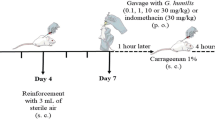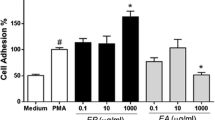Abstract
Zingiber officinale Roscoe, popular name ginger, is grown naturally in many parts of the world, including Brazil. Ginger is used in pharmaceutical, cosmetic, and food and beverage industries and the essential oil has been used in folk medicine for manifold conditions including as an analgesic, anti-inflammatory, and antirheumatic. The purpose of this study was to investigate the effects of ginger (Zingiber officinale Roscoe) essential oil (GEO) in an in vitro chemotaxis assay and on leukocyte–endothelial interactions in vivo. GEO was analyzed by GC–MS and the main components identified were ar-curcumene (59%), β-myrcene (14%), 1,8-cineol (8%), citral (7.5%), and zingiberene (7.5%). Oral administration of GEO (200–500 mg/kg) reduced the rolling and leukocyte adherence after 2 h of carrageenan injection (100 μg) into the scrotal chamber. The number of leukocytes migrated to the perivascular tissue 4 h after the irritant stimulus was also diminished. GEO in all doses tested (10−4, 10−3, or 10−2 μL/mL) caused a significant reduction of leukocyte chemotaxis (35.89 ± 4.33, 30.67 ± 0.70, and 35.85 ± 3.83%, respectively) toward casein stimuli. The data presented showed direct and systemic effects of GEO on leukocyte migration as an important mechanism of the anti-inflammatory action of ginger.



Similar content being viewed by others
References
Dusan F, Marián S, Katarína D, Dobroslava B (2006) Essential oils—their antimicrobial activity against Escherichia coli and effect on intestinal cell viability. Toxicol In Vitro 20:1435–1445
Barnes J (2003) Quality, efficacy and safety of complementary medicines: fashions, facts and the future—Part I—regulation and quality. Br J Clin Pharmacol 55:331–340
Ali BH, Blunden G, Tanira MO, Nemmar A (2008) Some phytochemical, pharmacological and toxicological properties of ginger (Zingiber officinale Roscoe): a review of recent research. Food Chem Toxicol 46:409–420
Daferera DJ, Tarantilis PA, Polissiou MG (2002) Characterization of essential oils from Lamiaceae species by Fourier transform Raman spectroscopy. Agric Food Chem 50(20):5503–5507
Shukla Y, Singh M (2007) Cancer preventive properties of ginger: a brief review. Food Chem Toxicol 45:683–690
Vendruscolo A, Bersani-Amado LE, Dantas JA, Bersani-Amado CA, Cuman RK (2006) Antiinflammatory and antinociceptive activities of Zingiber officinale Roscoe essential oil in experimental animal models. Indian J Pharmacol 38:58–59
Carrasco FR, Schmidt G, Romero AL, Sartoretto JL, Caparroz-Assef SM, Bersani-Amado CA, Cuman RK (2009) Immunomodulatory activity of Zingiber officinale Roscoe, Salvia officinalis L. and Syzygium aromaticum L. essential oils: evidence for humor- and cell-mediated responses. J Pharm Pharmacol 61:961–967
Adams RP (2001) Identification of essential oil components by gas chromatography/quadrupole mass spectroscopy. Allured, Illinois
Calixto JB, Campos MM, Otuki MF, Santos ARS (2004) Antiinflammatory compounds of plant origin. Part II. Modulation of pro-inflammatory cytokines, chemokines and adhesion molecules. Planta Med 70:93–103
Lee SK, Hong CH, Huh SK, Kim SS, Oh OJ, Min HY, Park KK, Chung WY, Hwang JK (2002) Suppressive effect of natural sesquiterpenoids on inducible cyclooxygenase (COX-2) and nitric oxide synthase (iNOS) activity in mouse macrophage cells. J Environ Pathol Toxicol Oncol 21:141–148
Santos FA, Rao VSN (2000) Antiinflammatory and antinociceptive effects of 1,8-cineole a terpenoid oxide present in many plant essential oils. Phytother Res 14:240–244
Juergens UR, Stober M, Schmidt-Schilling L, Kleuver T, Vetter H (1998) Antiinflammatory effects of eucalyptol (1.8-cineole) in bronchial asthma: inhibition of arachidonic acid metabolism in human blood monocytes ex vivo. Eur J Med Res 3:407–412
Juergens UR, Engelen T, Racké K, Stöber M, Gillissen A, Vetter H (2004) Inhibitory activity of 1,8-cineol (eucalyptol) on cytokine production in cultured human lymphocytes and monocytes. Pul Pharmacol Ther 17:281–287
Juergens UR, Stober M, Vetter H (1998) Inhibition of cytokine production and arachidonic acid metabolism by eucalyptol (1.8-cineole) in human blood monocytes in vitro. Eur J Med Res 3:508–510
Silva J, Abebeb W, Sousa SM, Duarte VG, Machado MIL, Matos FJA (2003) Analgesic and anti-inflammatory effects of essential oils of Eucalyptus. J Ethnopharmacol 89:277–283
Lee JY, Kang HS, Park BE, Moon HJ, Sim SS, Kim CJ (2009) Inhibitory effects of Geijigajakyak-Tang on trinitrobenzene sulfonic acid-induced colitis. J Ethnopharmacol 126:244–251
Serhan CN (2007) Resolution phase of inflammation: novel endogenous anti-inflammatory and proresolving lipid mediators and pathways. Annu Rev Immunol 25:101–137
Cassatella MA (1995) The production of cytokines by polymorphonuclear neutrophils. Immunol Today 16:21–26
Moore AR, Iwamura H, Larbre JP, Scott DL, Willoughby DA (1993) Cartilage degradation by polymorphonuclear leucocytes: in vitro assessment of the pathogenic mechanisms. Ann Rheum Dis 52:27–31
Wipke BT, Allen PM (2001) Essential role of neutrophils in the initiation and progression of a murine model of rheumatoid arthritis. J Immunol 167:1601–1608
Lloyd AR, Oppenheim JJ (1992) Poly’s lament: the neglected role of the polymorphonuclear neutrophil in the afferent limb of the immune response. Immunol Today 13:69–72
Edwards SW, Hallett MB (1997) Seeing the wood for the trees: the forgotten role of neutrophils in rheumatoid arthritis. Immunol Today 18:320–324
Dell’Aica I, Niero R, Piazza F, Cabrelle A, Sartor L, Colalto C, Brunetta E, Lorusso G, Benelli R, Albini A, Calabrese F, Agostini C, Garbisa S (2007) Hyperforin blocks neutrophil activation of matrix metalloproteinase-9, motility and recruitment, and restrains inflammation-triggered angiogenesis and lung fibrosis. J Pharmacol Exp Ther 321:492–500
Kumasaka R, Nakamura N, Fujita T, Murakami R, Shimada M, Osawa H, Yamabe H, Okumura K (2008) Beneficial effect of neutrophil elastase inhibitor on anti-Thy1.1 nephritis in rats. Nephrology 13:27–32
Riccioni G, Zanasi A, Vitulano N, Mancini B, D’Orazio N (2009) Leukotrienes in atherosclerosis: new target insights and future therapy perspectives. Mediators Inflamm 2009;ID737282
Smith CW (1993) Endothelial adhesion molecules and their role in inflammation. Can J Physiol Pharm 71:76–87
Mulder K, Colditz IG (1993) Migratory responses of ovine neutrophils to inflammatory mediators in vitro and in vivo. J Leukoc Biol 53:273–278
Roussel L, Houle F, Chan C, Yao Y, Bérubé J, Olivenstein R, Martin JG, Huot J, Hamid Q, Ferri L, Rousseau S (2010) IL-17 promotes p38 MAPK-dependent endothelial activation enhancing neutrophil recruitment to sites of inflammation. J Immunol 184:4531–4537
Li L, Huang L, Vergis AL, Ye H, Bajwa A, Narayan V, Strieter RM, Rosin DL, Okusa MD (2010) IL-17 produced by neutrophils regulates IFN-gamma-mediated neutrophil migration in mouse kidney ischemia-reperfusion injury. J Clin Invest 120:331–342
Lemos HP, Grespan R, Vieira SM, Cunha TM, Verri WA Jr, Fernandes KS, Souto FO, McInnes IB, Ferreira SH, Liew FY, Cunha FQ (2009) Prostaglandin mediates IL-23/IL-17-induced neutrophil migration in inflammation by inhibiting IL-12 and IFNgamma production. Proc Natl Acad Sci U S A 106:5954–5959
Hirota R, Roger NN, Nakamura H, Song H-S, Sawamura M, Suganuma N (2010) Anti-inflammatory effects of Limonene from Yuzu (Citrus junos Tanaka) essential oil on eosinophils. J Food Sci 75:H87–H92
Kwok BHB, Koh B, Ndubuisi MI, Elofsson M, Crews CM (2001) The anti-inflammatory natural product parthenolide from the medicinal herb Feverfew directly binds to and inhibits IκB kinase. Chem Biol 8:759–766
Nicolete R, Arakawa NS, Rius C, Nomizo A, Jose PJ, Da Costa FB, Sanz M, Faccioli LH (2009) Budlein A from Viguiera robusta inhibits leukocyte–endothelial cell interactions, adhesion molecule expression and inflammatory mediators release. Phytomedicine 16:904–915
Tamura EK, Jimenez RS, Waismam K, Gobbo-Neto L, Lopes NP, Malpezzi-Marinho EAL, Marinho EAV, Farsky SHP (2009) Inhibitory effects of Solidago chilensis Meyen hydroalcoholic extract on acute inflammation. J Ethnopharmacol 122:478–48516
Diaz-Gonzalez F, Gonzalez-Alvaro I, Campanero MR, Mollinedo F, del Pozo MA, Munoz C, Pivel JP, Sinchez-Madrid F (1995) Prevention of in vitro neutrophil-endothelial attachment through shedding of L-selectin by nonsteroidal antiinflammatory Drugs. J Clin Invest 95:1756–1765
Sakai A (1996) Diclofenac inhibits endothelial cell adhesion molecule expression induced with lipopolysaccharide. Life Sci 58(26):2377–2387
Srivastava KC (1986) Isolation and effects of some ginger components of platelet aggregation and eicosanoid biosynthesis. Prostaglandins Leukot Med 25:187–198
Flynn DL, Rafferty MF, Boctor AM (1986) Inhibition of human neutrophil 5-lipoxygenase activity by gingerdione, shogaol, capsaicin and related pungent compounds. Prostaglandins Leukot Med 24:195–198
Tjendraputra E, Tran VH, Liu-Brennan D, Roufogalis BD, Duke CC (2001) Effect of ginger constituents and synthetic analogues on cyclooxygenase-2 enzyme in intact cells. Bioorg Chem 29:156–163
Chrubasik S, Pittler MH, Roufogalis BD (2005) Zingiberis rhizoma: a comprehensive review on the ginger effect and efficacy profiles. Phytomedicine 12:684–701
Menezes GB, Reis WGP, Santos JMM, Duarte IDG, Francischi JN (2005) Inhibition of prostaglandin F2α by selective cyclooxygenase 2 inhibitors accounts for reduced rat leukocyte migration. Inflammation 29:163–169
Menezes GB, Rezende RM, Pereira-Silva PEM, Klein A, Cara DC, Francischi JN (2008) Differential involvement of cyclooxygenase isoforms in neutrophil migration in vivo and in vitro. Eur J Pharmacol 598:118–122
Acknowledgments
This study was supported by grants from CAPES (Coordenadoria de Aperfeiçoamento de Pessoal de Nível Superior) and CNPq (Conselho Nacional de Desenvolvimento Científico e Tecnológico), Brazil. We thank Mr. Jailson Araujo Dantas and Mrs. Celia Regina Miranda for technical assistance.
Conflict of interest
All the authors declare that they have no potential conflicts of interest associated with any work submitted for publication.
Author information
Authors and Affiliations
Corresponding author
Rights and permissions
About this article
Cite this article
Nogueira de Melo, G.A., Grespan, R., Fonseca, J.P. et al. Inhibitory effects of ginger (Zingiber officinale Roscoe) essential oil on leukocyte migration in vivo and in vitro. J Nat Med 65, 241–246 (2011). https://doi.org/10.1007/s11418-010-0479-5
Received:
Accepted:
Published:
Issue Date:
DOI: https://doi.org/10.1007/s11418-010-0479-5




